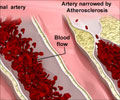Obese teen girls show altered lipid profile compared to boys who have high blood pressure and excessive blood levels of cholesterol and triglycerides (dyslipidemia).

The findings of study were obesity associated changes like increased levels of triglycerides and LDL, so-called ‘bad cholesterol’,, while decreased level of HDL, ‘good cholesterol’ seen in obese girls. whereas, obese boys displayed no significant differences in lipid profile.
“We compared obese and non-obese girls and boys aged 11-18, simultaneously addressing anthropometrics, lipid and lipoprotein profile, and hormone and neuropeptide levels, with a special emphasis on sex-dependent responses. To our knowledge, this is the first study to take this multifactor approach,” said Estefania Simoes, first author of the article.
This first multifactor approach study compared only anthropometrics, lipid and lipoprotein profile, and hormone and neuropeptide levels among both the sexes but did not reveal the effects of obesity.
Source-Eurekalert












